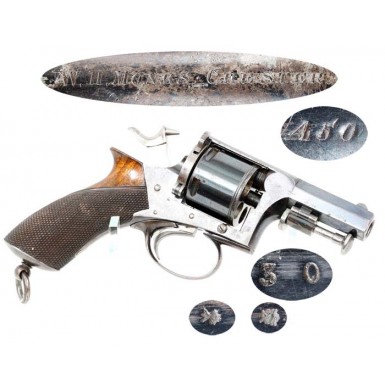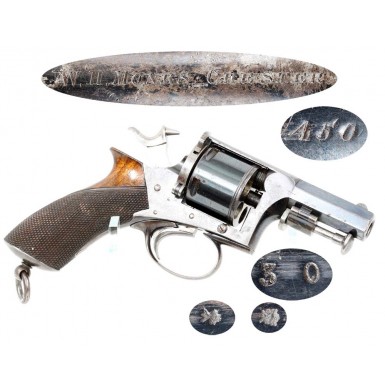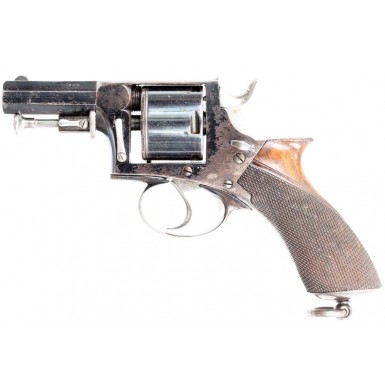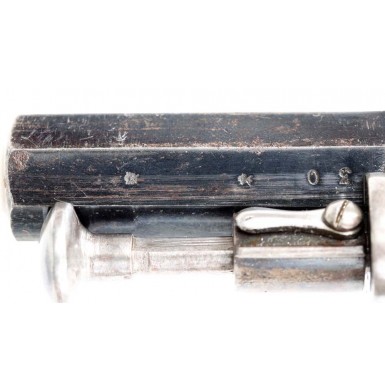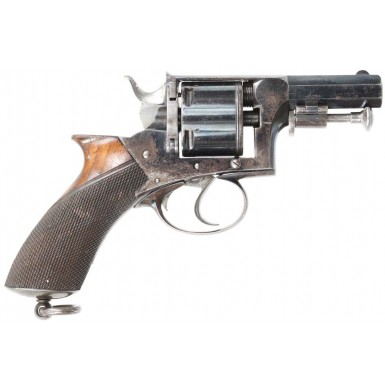Tipping & Lawden Hammer Safety Revolver
- Product Code: FHG-1940-SOLD
- Availability: Out Of Stock
-
$1.00
The Birmingham based gunmaking firm of Tipping & Lawden was trade name partnership between Thomas Tipping Lawden and Caleb Lawden, who established themselves as gun, rifle and pistol makers at 40 Constitution Hill in 1837, expanding to 40 & 41 Constitution Hill in 1852. In 1860, the firm added a London location at 18 Buckingham Street. In addition to the usual production of military pattern muskets and rifles (both for military contracts and commercial sale), the company manufactured sporting arms for the general gun trade both in England and abroad. The firm also established itself as a major manufacturer of handguns in Great Britain by the end of the 1850s. Their first major success in that vein was the manufacture of double action percussion revolvers under Willian Harding’s 1858 patents for Deane & Son in London (these were of the “Deane-Harding” pattern). In 1859 the firm procured the rights to manufacture Sharps’ Patent four-barrel pepperbox revolvers under a licensing agreement with C. Sharps & Company of the United States. Tipping & Lawden also secured their own patents during 1861 and 1862 for a breechloading mechanism (in both percussion and pin fire), a dropping barrel breech loader (with John Thomas) and a cane gun. On March 13, 1869 John Thomas, who was employed as a manager at Tipping & Lawden, was granted British Patent 779 / 1869. His patent was a for a cartridge revolver with a simultaneous extraction system. The patent actually covered three variations of the mechanism, but it appears that only the 1st type of action was produced in any quantity. Thomas entered into an agreement with Tipping & Lawden to produce the revolvers of his design, which they did from about 1869 until they were bought out in 1877 by P. Webley & Son. Tipping & Lawden were large enough players in the mid-19th century English firearms trade that when the Birmingham Small Arms Company LTD (BSA) was chartered in 1861, they held sixty of the 2,000 initial shares of stock. The BSA was the outgrowth of the Birmingham Small Arms Trade, a consortium of the 20 largest Birmingham arms makers that had formed a cooperative organization during the Crimean War and worked to assist their members in the acquisition and execution of large military arms contracts. The Thomas Patent revolver was a solid frame design with a longer than normal frame, which allowed enough space for the cylinder to slide forward about “ of an inch. The revolver loaded in a convention manner through a loading gate on the right rear of the frame. However, a very different system was used to unload the revolver. A small spring at the lower front of the frame was depressed, allowing the shooter to use the large, bulbous lug under the barrel to rotate the barrel counterclockwise through 180 degrees. This freed the barrel to be drawn forward which pulled the cylinder forward at the same time as well. A stationary star shaped extractor at the rear of the frame held the cartridges by their rims, and after the cylinder was pulled forward, any empty cartridges could be shaken loose, as they were no longer supported by the cylinder chambers. Unfired cartridges remained in place, as their exposed bullets were still within the chamber. The process of opening the revolver in this way created a large amount of torque, which helped to dislodge any stuck casings from the chambers and made for a very reliable extraction system. To close the action, the barrel was simply pushed back into its normal position and rotated clockwise to lock the action closed. The balance of the design was a typical English pattern double-action (“self-cocking”) revolver of the period, with the often-encountered exposed sear release at the upper rear of the triggerguard. The one exception was the inclusion of an interesting “hammer safety” device. This small wing shaped screw at the upper left rear of the frame served as both a hammer locking safety and a de-cocking device. With the screw fully tightened the action was locked and the hammer could not be cocked either manually or by pulling the trigger. By loosening the screw, the action functioned normally. If the hammer was fully cocked and the shooter wanted to de-cock the revolver, the screw could be tightened, and the trigger pulled. This would release the sear and the hammer, but the hammer would remain in the cocked position, supported by the hammer safety screw. Slowly releasing the pressure on the screw by loosening it would allow the hammer to drop into a safety notch, keeping the firing pin from contacting the primer of the cartridge in the chamber. The Thomas revolver was innovative and offered certain advantages to the user, particularly in terms of rapid unloading. However, the machining and required tolerances of the design made it more expensive to manufacture due to time and workmanship. As a result, in addition to manufacturing Thomas’ revolver, Tipping & Lawden produced a more traditional cartridge revolver. This gun was more akin to the Webley Royal Irish Constabulary (R.I.C.) model, with a solid frame, hinged loading gate and a center mounted ejector rod that was stored within the cylinder arbor and could be withdrawn and pivoted into position to eject empty cases when needed. This revolver retained two feature common to the Thomas Patent revolvers; a distinctive protruding hump at the upper rear of the grip and the thumb screw hammer safety. As these revolvers were universally manufactured for sale to other firearms retailers, they are rarely marked by Tipping & Lawden, but rather carry the name of the retailer on their topstrap. However, their features and profile make their origin unmistakable. It is reasonable to assume that the success that Tipping & Lawden were starting to enjoy with their various in-house and licensed handgun designs during the 1870s resulted in Webley’s acquisition of the company. Sometimes buying your competition is preferable to fighting them. As soon as Webley took the firm over, the Thomas Patent revolver was immediately dropped from the product line and the patent allowed to expire. The solid frame R.I.C. style revolver with the hammer safety suffered a similar fate, as Webley already offered comparable models. However, Webley did continue to manufacture the Sharps’ patent pepperboxes for some time, attesting to their popularity.
The Tipping & Lawden Hammer Safety Revolver offered here is in about VERY FINE condition. The gun generally conforms to the solid frame R.I.C. type design with a solid frame, hinged loading gate, central ejector rod and a double action lock mechanism. The handful of examples that I have ever been able to view have all had octagonal barrels, checkered one-piece walnut grips with the pronounce hump at the upper rear, a lanyard ring in the butt and of course the Tipping & Lawden “hammer safety” mechanism. All examples that I have examined have had blued frames, cylinders and barrels, however it would not surprise me to find that some were made with case hardened cylinders as were most of the Thomas’ Patent Revolvers. Invariably the guns are free of any markings indicating their manufacture by Tipping & Lawden and show only Birmingham commercial proof marks, serial number and caliber markings and often a retailer mark on the top strap. This gun is no exception and the only markings found on it are the Birmingham commercial proofs, serial (assembly) numbers, caliber mark and a retailer’s name. The proof marks are found on the lower left angled flat of the barrel, the right rear of the frame and between the chambers of the cylinder. The serial (or assembly) number 30 is found on the face of the cylinder arbor pin, on the ejector housing hinge, on the lower left angled flat of the barrel and on the face of the cylinder. The number is probably found internally as well. The upper left angled flat of the barrel is marked 450, indicating that the revolver is chambered for the .450 Boxer Mk 1 centerfire cartridge, known also as the .450 Adams, .450 Colt and by several other “proprietary” names, but all referring to the same .455” diameter bullet, weighing about 225 grains, and propelled by 13 grains of black powder. The bullet travelled about 650 ft/s and generated approximately 211 ft/lbs of muzzle energy, similar to other contemporary handgun cartridges like .44 S&W American. The topstrap is engraved W.H. MONKS CHESTER who was a gunmaker and retailer located at 65 Foregate Street in Chester, Cheshire from the late 1860s through the 1880s. In 1881 Monks took out a patent that essentially predicted the modern concept of “sleeving” vintage shotgun barrels that had become too worn to use. His patent, however, revolved around the use of the process in shotgun manufacture and has been noted as being similar to the mono-block process used by Beretta in the manufacture of their double-barreled shotguns.
As previously noted, this is a VERY FINE condition example of a scarce and apparently early production Tipping & Lawden Hammer Safety Revolver. The gun is one of the large-bore, .450 CF handguns, with a five-shot cylinder and a 3 1/8” octagonal barrel, making it quite concealable and perfect for carry in an overcoat pocket. The revolver retains much of its original finish, about 60% overall, and is very attractive. The revolver is blued throughout with some of the small parts left “in the white”. The barrel retains about 65%+ original bright blue with some fading, dulling and wear. Most of the wear and loss is along the sharp edges of the octagonal barrel. The areas of the barrel where the color had faded or worn have a smooth plum-brown patina. There is some lightly scattered oxidized discoloration and staining flecked along the barrel, but it is minimal and blends well with the rich blue. The cylinder retains about 85%+ bright blue and is very striking. Again, the loss appears mostly along contact points and edges, and appears to be the result of light carry wear and use. The areas where the finish has worn have a smooth plum-brown patina like the barrel. There is some lightly oxidized discoloration and staining present on the cylinder as well, mostly on the front and rear faces. The frame retains about 20%+ of its original bright blued finish with the majority of the loss due to flaking. The areas of finish loss have a similar plum-brown patina as found on the barrel and cylinder of the revolver. Again, small areas of minor oxidized discoloration and staining are present on the frame, as well as some flecks of minor surface roughness and very minor pinpricking. There is some minor surface oxidation inside the frame recesses, mostly on the interior front edge of the frame where the corrosive gases from cylinder chambers would escape when firing. The blued triggerguard and buttcap retain only traces of original blue, and show a smooth plum-brown patina as well. The hammer is finished it the white and shows flecks of oxidized discoloration on its surfaces. The cylinder arbor pin, ejector rod and loading gate are also finished in the white and show similar flecks of lightly oxidized surface discoloration. The bore of the revolver is in about VERY GOOD condition and remains mostly bright and shiny. The bore shows scattered light pitting most of its length, along with a couple of patches of more moderate pitting about the middle of the barrel. The bore is rifled with five narrow grooves and five wider lands, that all remain relatively crisp and sharp. The revolver retains its original lanyard ring in the butt and the original front sight on the top of the barrel near the muzzle. The revolver is mechanically EXCELLENT and functions perfectly in every way. The double action mechanism functions flawlessly and the revolver times, indexes and locks up exactly as it should. The unique hammer safety mechanism is fully functional as well. The loading gate locks securely into place when closed and opens smoothly when the catch is released. The checkered one-piece walnut grip remains in about FINE condition as well. The grip is solid and complete and free of any breaks, cracks or repairs. The grip shows some scattered bumps, dings and bruises from handling and use, but no abuse, and the majority of the checkering remains crisp and sharp.
Overall this is a really wonderful example of a fairly scarce and rather high condition Tipping & Lawden Hammer Safety Revolver that is 100% complete, correct and original in every way. The gun retains most of its original finish and displays wonderfully. The revolver and its unique safety mechanism operate flawlessly, and the gun remains in very crisp condition throughout. This gun is 100% in every way and will be a great addition to your collection of 19th century English cartridge handguns, and would be a great juxtaposition to a group of solid frame Webley revolvers from the same period.
SOLD
